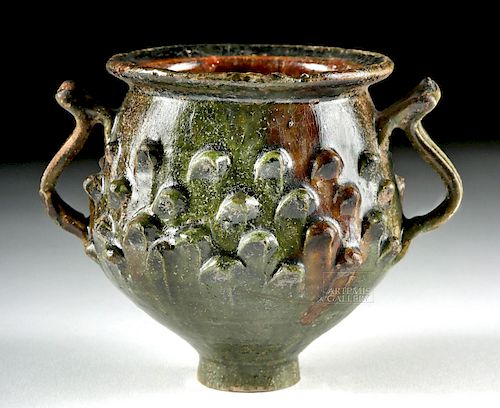Roman Glazed Ceramic Pinecone Vessel, ex-Royal Athena
Lot 55a
About Seller
Artemis Gallery
686 S Taylor Ave, Ste 106
Louisville, CO 80027
United States
Selling antiquities, ancient and ethnographic art online since 1993, Artemis Gallery specializes in Classical Antiquities (Egyptian, Greek, Roman, Near Eastern), Asian, Pre-Columbian, African / Tribal / Oceanographic art. Our extensive inventory includes pottery, stone, metal, wood, glass and textil...Read more
Estimate:
$5,000 - $7,500
Absentee vs Live bid
Two ways to bid:
- Leave a max absentee bid and the platform will bid on your behalf up to your maximum bid during the live auction.
- Bid live during the auction and your bids will be submitted real-time to the auctioneer.
Bid Increments
| Price | Bid Increment |
|---|---|
| $0 | $25 |
| $300 | $50 |
| $1,000 | $100 |
| $2,000 | $250 |
| $5,000 | $500 |
| $10,000 | $1,000 |
| $20,000 | $2,500 |
| $50,000 | $5,000 |
| $100,000 | $10,000 |
| $200,000 | $20,000 |
About Auction
By Artemis Gallery
Jun 20, 2019
Set Reminder
2019-06-20 10:00:00
2019-06-20 10:00:00
America/New_York
Bidsquare
Bidsquare : Ancient / Ethnographic From Around the World
https://www.bidsquare.com/auctions/artemis-gallery/ancient-ethnographic-from-around-the-world-4217
Around the world & back in time - be amazed at the treasures you will find. Antiquities from Egypt, Greece, Italy and the Near East, Asian, Pre-Columbian, African / Tribal / Oceanic, Native American, Spanish Colonial, Russian Icons, Fine Art, much more! All categories, all price ranges.. all legal Artemis Gallery info@artemisgallery.com
Around the world & back in time - be amazed at the treasures you will find. Antiquities from Egypt, Greece, Italy and the Near East, Asian, Pre-Columbian, African / Tribal / Oceanic, Native American, Spanish Colonial, Russian Icons, Fine Art, much more! All categories, all price ranges.. all legal Artemis Gallery info@artemisgallery.com
- Lot Description
Roman, Imperial Period, ca. 1st century BCE to 1st century CE. A stunning glazed ceramic chalice with four rows of staggered pinecone scales (the pinecone motif perhaps referencing the cult of Dionysos, as the god of wine carried a staff or thyrsus topped by a pine cone), twin sinuous ribbed handles mimicking glass trailing, the exterior glazed in hues of rich verdant green, the interior of golden orange - all gracefully supported by a diminutive circular base. For centuries, Greco-Roman pottery was decorated via the black-figure and red-figure techniques; however, in the second half of the first century BCE, the Romans created this interesting variation - covering vessels with vitreous glazes that made for a beautiful glossy colors like the stunning greens and golden oranges gracing this piece. Size: 4.625" W handlespan x 3.625" H (11.7 cm x 9.2 cm)
According to an article published in the journal of the Princeton University Art Museum, "When Cicero was travelling in the east in 50 B.C., his friend Atticus asked him to order 'Rhosica vasa,' presumably vases made in the town of Rhosus on the modern Gulf of Alexandretta, and presumably vases of unusual ceramic interest. Cicero expressed surprise, as we know from one of his letters, since Atticus, like the well-to-do of his day, ate off metal dishes, but apparently he complied with his friend's request." ("A Lead-Glazed Cup", F.F.J. Record of the Art Museum, Princeton University Vol. 20, No. 2 (1961), pp. 57-59.)
Provenance: private East Coast, USA collection; ex-Dr. Sid Port collection, California, USA, acquired in the 1980s
All items legal to buy/sell under U.S. Statute covering cultural patrimony Code 2600, CHAPTER 14, and are guaranteed to be as described or your money back.
A Certificate of Authenticity will accompany all winning bids.
We ship worldwide and handle all shipping in-house for your convenience.
#143855Repaired from what looks like three large pieces. Chips to rim. Fine craquelure on the glazed surface. Old Royal Athena label on the underside of the base.Condition
- Shipping Info
-
All shipping is handled in-house for your convenience. Your invoice from Artemis Gallery will include shipping calculation instructions. If in doubt, please inquire BEFORE bidding for estimated shipping costs for individual items.
-
- Buyer's Premium



 EUR
EUR CAD
CAD AUD
AUD GBP
GBP MXN
MXN HKD
HKD CNY
CNY MYR
MYR SEK
SEK SGD
SGD CHF
CHF THB
THB
















